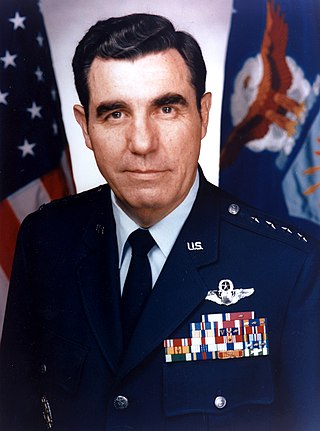
John Michael Loh is a retired four-star general in the United States Air Force (USAF) who last served as Commander, Air Combat Command from June 1992 to July 1995. His other four-star assignment include being the 24th Vice Chief of Staff of the Air Force from June 1990 to March 1991, and Commander, Tactical Air Command from March 1991 to June 1992.

Joseph William Ashy, is a retired United States Air Force (USAF) general who was commander in chief of North American Aerospace Defense Command and United States Space Command, and commander of Air Force Space Command, headquartered at Peterson Air Force Base, Colorado. As commander of NORAD, General Ashy was responsible for the air sovereignty of the United States and Canada, as well as for providing tactical warning and attack assessment. As USCINCSPACE, he commanded the unified command responsible for directing space control and support operations including theater missile defense. As COMAFSPC, he directed satellite control, warning, space launch and ballistic missile operations missions through a worldwide network of support facilities and bases.
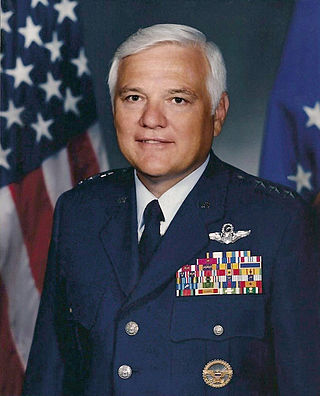
Lieutenant General Buster Cleveland Glosson was the deputy chief of staff for plans and operations at the headquarters of the United States Air Force (USAF) in Washington D.C. He was responsible to the secretary of the Air Force and chief of staff for the planning, operations, requirements and force structure necessary to support military operations. As the USAF operations deputy to the Joint Chiefs of Staff, he determined operational requirements, concepts, doctrine, strategy, training and the assets necessary to support national security objectives and military strategy.

William Wallace Momyer was a general officer and fighter pilot in the United States Air Force (USAF). Among his notable posts were those commanding Air Training Command, the Seventh Air Force during the Vietnam War, and Tactical Air Command (TAC). During his tour in Southeast Asia, he was concurrently the deputy commander of Military Assistance Command, Vietnam (MACV) for air operations and thus responsible for Operation Rolling Thunder, the air campaign against North Vietnam, which Momyer executed in the face of micromanagement from President Lyndon B. Johnson and Secretary of Defense Robert S. McNamara.

Richard Earl Hawley is a retired four-star general in the United States Air Force (USAF). He served as commander of Air Combat Command, headquartered at Langley Air Force Base, Virginia. As commander, Hawley was responsible for organizing, training, equipping and maintaining combat-ready air forces for rapid deployment and employment in the United States and worldwide. Hawley maintained command of 1,050 aircraft and approximately 103,400 active-duty military members and civilian personnel at 27 major installations in the United States, Panama, Iceland and the Azores, and, when mobilized, more than 64,400 Air National Guard and Air Force Reserve members
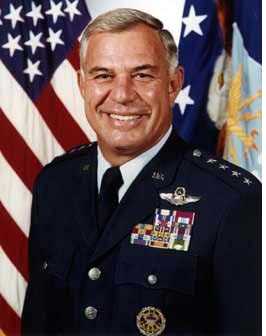
General John George Lorber was a retired four-star general in the United States Air Force (USAF). He served as commander of Pacific Air Forces, Hickam Air Force Base, Hawaii. As commander, he had responsibility for USAF activities spread over half the world in a command that supports 44,000 airmen serving principally in Hawaii, Alaska, Guam, Republic of Korea and Japan.
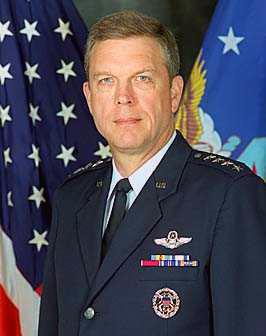
Patrick K. Gamble is a retired president of the University of Alaska and a retired United States Air Force (USAF) general whose assignments included service as Commander, Pacific Air Forces, Hickam Air Force Base, Hawaii.

General James Burr Davis is a retired U.S. Air Force general and was chief of staff, Supreme Headquarters Allied Powers Europe in Mons, Belgium.

General James Ferguson was a U.S. Air Force general and was commander of the Air Force Systems Command at Andrews Air Force Base, Maryland.

Carlos Maurice Talbott was a United States Air Force officer who attained the rank of lieutenant general and was vice commander in chief of the Pacific Air Forces, headquartered at Hickam Air Force Base.
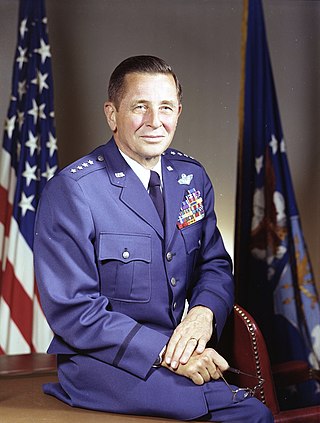
General Robert James Dixon was a four-star general and Command Pilot in the United States Air Force (USAF) who served as Commander, Tactical Air Command (COMTAC) from 1973 to 1978. He also served simultaneously as commander in chief of U.S. Air Forces for both the U.S. Atlantic Command and U.S. Readiness Command.

Kenneth Walter North was a brigadier general in the United States Air Force as well as a prisoner of war during the Vietnam War. After his release, he commanded various units and was eventually promoted to general in 1982.

Billy Martin Minter was a four-star general in the United States Air Force (USAF). He served as commander in chief, United States Air Forces in Europe and commander of Allied Air Forces Central Europe, with headquarters at Ramstein Air Base, West Germany.

Robert Dale Russ was a United States Air Force (USAF) general and commander of Tactical Air Command.

Jack Irvin Gregory is a former general in the United States Air Force and the former commander in chief of the Pacific Air Forces.

Lloyd Richardson Leavitt Jr. was an American Air Force lieutenant general. As vice commander in chief of the Strategic Air Command, Offutt Air Force Base, Nebraska, he fulfilled the responsibilities of the SAC commander in chief in his absence. He was also the commander's principal adviser in the formulation of SAC policies, plans, and directives.
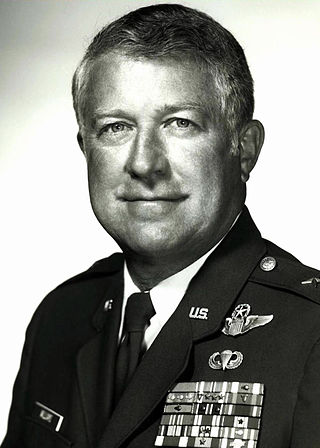
Gordon E. Williams is a retired United States Air Force officer. A command pilot with more than 4,000 flying hours, he flew numerous Air Force and Navy aircraft. Upon his retirement on 1 August 1988, he was the director for plans and policy, J-5, Headquarters United States European Command, Stuttgart-Vaihingen, West Germany.

Craven C. Rogers Jr. was a lieutenant general in the United States Air Force who served as deputy commander in chief of the U.S. Central Command at MacDill Air Force Base, Florida. The command was tasked with achieving United States national objectives in Southwest Asia, the Persian Gulf, and the Horn of Africa. Rogers was born in 1934, in Galveston, Texas. He earned a Bachelor of Science degree in engineering from the U.S. Military Academy in 1957 and a master's degree in business administration from The George Washington University. He completed Squadron Officer School in 1962 and the Industrial College of the Armed Forces in 1973. Upon graduation from the academy he was commissioned as a second lieutenant in the Air Force. After completing pilot training in September 1958 he was assigned to Tactical Air Command at Williams Air Force Base, Ariz., for gunnery training in the F-86F. With the phaseout of the F-86F, Rogers transferred in June 1959 as an instructor pilot to Air Training Command, Vance Air Force Base, Oklahoma. He completed F-101A transition training in September 1964 and then was assigned as a tactical fighter pilot with the 91st Tactical Fighter Squadron, Royal Air Force Station Bentwaters, England. In 1965 his squadron became the first unit in the United States Air Forces in Europe to transition to the F-4. Rogers assumed duties in the Standardization and Evaluation Section of the 81st Tactical Fighter Wing at Bentwaters in November 1966. In September 1967 he transferred to Nellis Air Force Base, Nevada, where he completed the F-4 Fighter Weapons School. In January 1968 he was assigned to the 557th Tactical Fighter Squadron, 12th Tactical Fighter Wing, Cam Ranh Bay Air Base, South Vietnam, as a flight commander and squadron weapons officer. He subsequently served as the wing weapons officer and assistant chief of weapons and tactics for 12th Tactical Fighter Wing. He flew 255 combat missions and 435 combat flying hours in the F-4C. He returned from Southeast Asia in February 1969 and was assigned to the Fighter and Reconnaissance Manning Section, Air Force Military Personnel Center, Randolph Air Force Base, Texas. He became chief of the section in 1971. Upon graduation from the Industrial College of the Armed Forces in August 1973, Rogers became deputy commander for operations, 1st Tactical Fighter Wing, MacDill Air Force Base, Florida. In June 1975 he transferred to Headquarters United States Air Force, Washington, D.C., as chief, Tactical Division, Directorate of Operational Requirements, Office of the Deputy Chief of Staff, Research and Development. In July 1977 Rogers was assigned as vice commander of the 4th Tactical Fighter Wing, Seymour Johnson Air Force Base, North Carolina. In June 1978 he became commander of the wing. He returned to Air Force headquarters in July 1980 and served as military assistant to the secretary of the Air Force. From June 1983 to July 1985 he was commander of United States Air Forces Korea; commander, United Nations Command Air Component; and commander, 314th Air Division, with headquarters at Osan Air Base, South Korea. He also was commander of the Korean Air Defense Sector, director of readiness and combat operations, and chief of staff of the Air Component Command/Combined Forces Command. Rogers then transferred to Hickam Air Force Base, Hawaii, as vice commander in chief, Pacific Air Forces. In December 1986 Rogers returned to Osan Air Base as commander, 7th Air Force; deputy commanding general, U.S. Forces Korea (Seoul); and deputy commander in chief, United Nations Command (Seoul). He is a command pilot with 5,200 flying hours. His military awards and decorations include the Defense Distinguished Service Medal with oak leaf cluster, Distinguished Service Medal, Legion of Merit with two oak leaf clusters, Distinguished Flying Cross with oak leaf cluster, Bronze Star Medal, Meritorious Service Medal with oak leaf cluster, Air Medal with 13 oak leaf clusters, Air Force Commendation Medal, Korean Order of National Security Merit (Chunsu) and Korean Order of National Security Merit (Kuksun). He was promoted to lieutenant general January 1, 1987, with same date of rank. He retired on April 1, 1991, and died on August 4, 2016.

Howard Wesley Leaf was a lieutenant general in the United States Air Force. He served as a fighter pilot during the Korean War and Vietnam War and retired as assistant vice chief of staff at the Pentagon in 1984.

Melbourne Kimsey was a brigadier general in the United States Air Force who served as director of the Cheyenne Mountain Complex from 1981 to 1983,



















